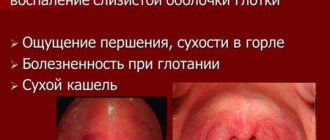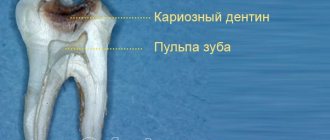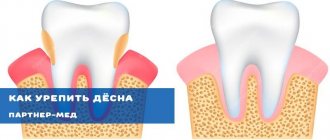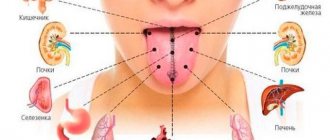Cervical caries, which occurs at or under the gum, is considered one of the most dangerous forms of caries. In the cervical area, tooth enamel is more vulnerable to cariogenic microbes, so pathology develops very quickly. In the article we will consider the features of the course and methods of treatment of cervical caries.
The structure of a tooth, when it comes to its structure, includes three main elements: the root, the neck and the crown. The first two are hidden by soft tissue. The enamel on them is thinner, and there are fewer minerals in it than on the visible part, so it is more vulnerable to cariogenic bacteria. Caries that develops in the area where the tooth comes into contact with the gums and under them is called cervical or root caries. It occurs mainly in adults over 30 years of age, and can appear on both the front and chewing teeth.
In this article
- Why does cervical caries occur?
- Stages of cervical caries
- How is cervical caries diagnosed?
- How to treat initial cervical caries
- How is advanced cervical caries treated?
- How to treat cervical caries on the front teeth
- What you can do at home
The problem with cervical caries is that it is almost asymptomatic until the third stage. The person does not complain of pain or discomfort, there is no visible destruction, and therefore treatment begins late. At the same time, basal caries progresses rapidly. The disease does not pose a serious danger if you visit the dentist every six months. People who rarely visit dental offices are at risk of losing a tooth. Let's talk about the causes and symptoms of cervical caries.
What is cervical caries?
Visually, a human tooth consists of three parts - crown, neck, roots.
- The crown is covered with enamel, rises above the gum and we can see it.
- The neck is the part of the tooth at the gum level. At this point, the crown passes into the root, and the tooth enamel into the cement.
- The root is the part of the tooth located in the alveolar socket that we cannot see.
Thus, cervical caries is a pathological process that occurs at the level of the neck of the tooth. It affects the lower part of the crown and can spread under the gum.
Important! In some cases, it is quite difficult to distinguish cervical caries from a wedge-shaped tooth defect, smoker plaque, tartar or fluorosis. Therefore, if you detect any changes in the color and surface of the tooth enamel, it is better to immediately contact your dentist. An experienced specialist will conduct a differential diagnosis of the pathology and identify the cause of the defect.
What are the stages of caries?
In caries, according to the depth of damage to dental tissues, different stages are distinguished - chalk spots, as well as superficial, medium and deep caries.
They are characterized by the following types of destruction:
- With caries at the spot stage, a white spot appears on the surface of the enamel, which is also called chalky. This is a zone of demineralization. That is, the enamel in this place is actively losing minerals, in particular calcium, but a carious cavity has not yet formed in the tooth.
- With superficial caries, the destruction is already more significant: a carious cavity forms in the tooth, but so far its localization is limited to the top layer - the enamel - and does not affect the dentin layers.
- Middle caries is the third stage of destruction of dental tissue. The carious cavity increases in size and penetrates into the dentin - the hard tissue of the tooth, which makes up its main part.
- At the stage of deep caries, the cavity with destroyed tissue is still located in the dentin, but it is already as close as possible to the pulp. That is why deep caries is often complicated by pulpitis - inflammation in the neurovascular bundle of the tooth.
You can count on the most favorable prognosis, simple and painless treatment, and minimal financial costs if a person begins to treat dental caries in the stain stage. The later he goes to the doctor, the more complex manipulations will be required for treatment and the more expensive it will be.
Features of this type
Among the features of cervical caries, three important points are distinguished.
- Neck - in this place the enamel is poorly formed, weakly protects the dentin and turns into cement. In essence, this is the most vulnerable place of the tooth. Caries arising in this place leads to rapidly progressive destruction of hard tissues and the subsequent formation of a cavity in the dentin. Without treatment, serious complications (pulpitis and periodontitis) cannot be avoided.
- Due to poorly formed enamel, cervical caries can spread deep into hard tissues and across the entire surface of the cervix - around the lower part of the crown, thereby covering the tooth on all sides. In this case, cervical caries turns into circular dental caries, which can lead to breaking off the crown of the tooth if you do not consult a dentist in time on how to treat it.
- Unlike the pathological process that affects the crown of the tooth, cervical caries can be very painful. This is explained by the proximity of the pulp to the outer edge of the neck. The loose fibrous tissue of the pulp is penetrated by a large number of nerve endings and reacts with lightning speed to the slightest irritants - cold, heat, sour, sweet.
Important! Cervical caries progresses quite quickly. If you detect the first signs of pathology, you must contact your dentist as soon as possible and undergo adequate treatment. Otherwise, complications and tooth loss are inevitable.
Features of cervical caries in a child
In most cases, cervical caries affects the teeth of adult patients, aged 30–40 years. At an early age, the pathology is much less common, but has a complicated course and very quickly turns into circular caries, which is fraught with the loss of a baby tooth and damage to the rudiments of permanent teeth.
Development of cervical caries
In the clinical picture of the pathology, there are four main stages.
- Stain stage – a demineralized area resembling a chalk stain appears on the tooth enamel. There is often no pain.
- Superficial cervical caries - demineralization of the enamel progresses. The chalk stain becomes a little loose, darkens, changes color and may react to external stimuli. In this case, the pathological process does not yet affect the enamel-dentin junction and does not spread deep into the tooth.
- Medium cervical caries - a pathological process that affects the enamel-dentin junction, penetrates deep into the dentin, which is accompanied by painful sensations not only to irritants, but also at rest.
- Deep cervical caries - a pathological process affects dentin and reaches the peripulpal area. Dentin destruction is accompanied by severe pain and characteristic symptoms.
Important! After passing through four stages of development, cervical caries becomes a complicated form. First, it is pulpitis - inflammation of the internal tissue of the tooth, and then periodontitis - inflammation of the periodontium.
How does caries develop?
The human oral cavity contains many bacteria that actively participate in the decomposition of food. When we eat large amounts of carbohydrates, cariogenic bacteria ferment the sugars and convert them into acid. It has a damaging effect on enamel, dentin and other dental tissues. As a result, a disease such as caries develops.
In most cases, dental caries does not occur overnight. This process is relatively slow and sluggish. However, if nothing is done, then gradually the initial caries, in which the damage is insignificant, will go into a deep stage or even into pulpitis and periodontitis. In this case, complex treatment is required and there is a risk of infection or tooth loss.
Causes of cervical caries
Currently, local changes in the acid-base balance (pH) on the surface of tooth enamel, which leads to its demineralization, are considered the main cause of any caries, including cervical caries. As a rule, pH fluctuations in the direction of increasing acidity are observed due to the active activity of microorganisms living in dental plaque and under its deposits.
Thus, the main reason for the development of cervical caries is dental plaque. However, its presence does not always lead to the development of pathology. For the appearance of caries, the influence of other negative factors is also necessary, which act as a trigger for pathology.
- Unbalanced diet with a predominance of carbohydrates.
- Insufficient salivation.
- Lack of fluoride in the body.
- Eating too soft food.
- Poor oral hygiene.
- Frequent stress.
- Smoking.
- Changes in the body's hormonal balance, including during puberty and pregnancy.
- Long-term use of medications.
Interesting to know! Frequent snacking without subsequent oral hygiene can lead to the development of cervical caries. Of particular danger in this regard are food products with a high sugar content, under the influence of which the vital activity of microorganisms is activated. The problem is that saliva simply does not have time to neutralize the resulting acids and they cause demineralization of tooth enamel. There is only one way to resist the destructive process - after each snack containing sugar-containing foods, you need to thoroughly brush your teeth. Well, or, as a last resort, use sugar-free chewing gum for the next 10 to 15 minutes.
Ozone therapy and laser treatment of caries
In some clinics, initial caries is treated with ozone therapy. The affected area of the tooth is exposed to ozone, which causes the death of pathogenic microorganisms, neutralizes the damaging effects of organic acids, and helps restore the mineral balance of the enamel.
The procedure does not cause pain, so it does not require anesthesia. The duration of treatment with ozone is less than a minute. Typically, ozone therapy is combined with remineralizing measures or sealing fissures (natural grooves on the teeth).
Another method is laser treatment. The affected tissue is exposed to a laser beam, which destroys bacteria and stops the proliferation of microbes. Laser treatment is painless, does not leave cracks in the enamel coating of the tooth, and is suitable even for children.
How best to treat a particular patient’s teeth and which method to choose is decided by the dentist after a preliminary diagnosis.
Do you have cervical caries - its symptoms
Dentists recommend examining the oral cavity and tooth surfaces daily. Detection of the following signs may indicate the development of cervical caries.
- Tooth enamel has lost its natural shine and has become rough.
- On the enamel, in the area of the neck of the tooth, any light or dark spots are noticeable.
- Accumulations of plaque, tartar or smoker's plaque are found on the neck of the tooth.
- Increased sensitivity of teeth to external irritants - cold, hot, sour, sweet, chewing food, brushing, etc.
- On the surface of the tooth, in the neck area, depressions and chips are found.
- Persistent bad breath.
- Tooth pain – aching, throbbing, short-term or long-term.
- Redness and swelling of the gums in the neck of the tooth.
In some cases, at the stage of medium and deep cervical caries, symptoms of general malaise, headache, insomnia and increased body temperature may be observed.
Important! In young children, in addition to the above signs of pathology, appetite often worsens. The child may become capricious, cry for no reason, and avoid communication.
Diagnosis of the disease
In the early diagnosis of pathology, special attention is paid to differentiating cervical caries from outwardly similar dental defects - wedge-shaped defect, smoker's plaque, tartar, fluorosis.
To make an accurate diagnosis and determine the stage of the carious process, the following diagnostic methods are used.
- Visual inspection using a dental mirror or probe.
- X-ray of teeth.
- Thermal diagnostics.
- Caries detector - staining the affected area of enamel with a dye.
In particularly difficult cases, transluminescence is used to detect a hidden pathological process - transillumination of the inner (or outer) side of the tooth with a bright light source.
Dark spot stage and its symptoms
At the very beginning of the formation of pathology, minor white spots appear. Over time, the affected tissue begins to grow, microorganisms penetrate the pores of the enamel, as a result of which the spots begin to darken and the next stage begins - the dark spot stage. As a rule, the front teeth are affected first.
One of the first symptoms of caries in the dark spot stage is the appearance of a sore throat in the mouth, most often this sign appears immediately after eating. Also, the enamel loses its shine, teeth lose their hardness, and porous areas appear that tend to absorb various dyes. It is worth noting that there is no pain or discomfort.
How to treat cervical caries
Many of us, having learned better about this type of caries, ask the question - is it possible to cure it? The answer is simple - yes, you can! The choice of treatment method directly depends on the stage of development of cervical caries. All dental procedures are performed under local anesthesia, since the proximity of the gum and pulp makes this area very sensitive to external irritants.
Treatment of cervical caries at the spot stage
Early detection of the pathological process allows caries to be cured without serious surgical intervention. At the stain stage, special attention is paid to remineralization of the damaged area of enamel. Therapy is carried out in several stages.
- Removing dental plaque.
- Quick treatment of chalk stains with a slightly acidic solution.
- Washing the stain.
- Application of remineralizing preparations based on calcium gluconate or sodium fluoride.
To improve the penetration of remineralizing drugs deep into tooth enamel, electrophoresis can be used.
Interesting to know! In progressive dental clinics, for the treatment of pathology at the stain stage, the method of infiltration-impregnation of the affected area of enamel with polymerizing resin ICON can be used. Under the influence of UV radiation, it tightly seals the demineralized area, which stops the further development of the pathological process.
Treatment of superficial, middle and deep cervical caries
In cases where the pathological process has already spread deep into the enamel or dentin, the affected area is prepared, followed by replacement (filling) of the lost tooth tissue. Dental intervention takes place in several stages.
- Removing dental plaque.
- Application of an isolating system to facilitate the subsequent procedure.
- Preparation of the affected area with a drill.
- Antiseptic treatment of the formed cavity.
- Applying therapeutic pads to the bottom of the cavity (according to indications).
- Treatment of the cavity with phosphoric acid (using first generation adhesives).
- Application of dental adhesive.
- Filling.
- Grinding and polishing of the filling.
Treatment of cervical caries of anterior teeth can be carried out using a special inlay - a microprosthesis made of composite materials, ceramics or metal-ceramics. Its application reliably fills the carious cavity, completely restoring the anatomical shape of the tooth and the natural color of the enamel.
Interesting to know! In modern dentistry, preparation is possible without the use of a drill. Tooth damage can be removed using a laser, ozone or air abrasive method. The latter is not used on cervical caries of a wisdom tooth, since the inconvenient location of the third molar makes it difficult to position the tip to supply an air-abrasive flow.
Methods for diagnosing initial caries
A lesion can be identified using several basic diagnostic methods:
- Teeth staining.
This is the most common method using a methylene blue solution, as well as a special tool called a caries detector. When applied, these substances can turn the affected areas pink.
- Drying.
One of the diagnostic methods is drying the teeth. First, they are treated with hydrogen peroxide, then dried using cotton swabs and warm air. Such manipulations make it possible to detect even minor stains on the teeth.
- UFO-stomatoscopy.
Before the procedure begins, the teeth are cleaned of plaque, which allows the specialist to determine the location of the destructive process.
- Radiography.
This technique is most often used for contact caries. In the photographs, the affected areas appear as small spots.
What to do if a tooth hurts after treatment of cervical caries?
The presence of pain is possible in two cases - a natural reaction of the body to the intervention or improper treatment. In the first case, it goes away on its own, after 2–3 days. In the second case, most likely the dentist incorrectly determined the depth of the pathological process and did not remove the nerve endings of the pulp. Or the pulp itself was damaged, which led to the development of undetected pulpitis.
Important to remember! If within three or more days after treatment the pain does not go away and intensifies, or additional symptoms appear against its background (fever, headache, general malaise), then you should immediately consult a dentist.
How can caries be detected in the chalk spot stage?
Most often, a person goes to the dentist if a tooth bothers him - it hurts, aches, reacts to cold or hot. However, at the initial stage, caries may not manifest itself in any way. The tooth does not cause concern and in most cases does not hurt. Therefore, detecting dental caries in the staining stage is more difficult than it seems. In order not to miss the onset of the disease and stop the process of carious damage to teeth at an early stage, it is recommended to regularly examine the enamel surface for discoloration, and also visit the dentist twice a year, even if there are no complaints.
Treatment at home
Treatment of cervical caries at home is possible only at the initial stage - a chalk spot. And only after a preliminary consultation with a dentist! If the condition of the demineralized area of enamel does not cause concern, then the specialist may prescribe the use of drugs based on fluoride and calcium. For example, “Fluorovarnish” is used to treat the affected area according to the instructions, the mouth is rinsed with an aqueous solution of sodium fluoride, and calcium gluconate is taken orally.
During home treatment, regular toothpaste should be replaced with a special one - with a high content of fluoride and calcium. For example, use “PresidentUnique” or “Ftorodent” therapeutic and prophylactic products for daily oral hygiene. They can also be applied locally to the affected area of enamel.
Important! The use of traditional medicine (decoctions, lotions, infusions) does not cure cervical caries, but only slightly relieves pain. This creates the illusion of recovery, but does not solve the problem and leads to aggravation of the pathological process.
Classification
There are several layers of this degree of caries:
- surface
. The amount of fluoride decreases, minor areas are affected;
- subsurface.
Calcium levels decrease, enamel permeability increases;
- central.
The calcium level decreases significantly, the enamel quickly loses strength;
- intermediate.
There are some changes, the microspace has a volume of 15-17%;
- area of shiny enamel.
Relatively normal condition.
Prevention
Considering the reasons for the development of pathology, the prevention of cervical caries should be aimed at maintaining oral hygiene and strengthening tooth enamel. To achieve these goals, it is advisable to carry out the following activities.
- Regular oral hygiene, including after each meal.
- Using floss, dental brushes, and rinses to thoroughly clean the interdental spaces.
- Regular removal of tartar and plaque in dentistry.
- Home use of fluoride-containing toothpastes or fluoridation of teeth in dentistry.
- Correction of the diet towards limiting the consumption of sugar-containing foods.
- Taking vitamin-mineral complexes with calcium, vitamin D and magnesium.
- Sealing of blind pits in the area of the tooth neck with polymers.
To prevent the development of cervical caries, it is recommended to undergo regular preventive examination by a dentist - at least 1-2 times a year. Timely identification of the problem will help localize the pathological process and avoid its complications.
Traditional methods in the fight against cervical caries
In order to get rid of cervical caries, you can also use folk remedies. However, you need to understand that they can only help at the initial stage of progression of this disease, when a small stain has just appeared on the tooth.
What means are suitable for this?
- Decoction of onion peels: boil the peels, let them sit overnight and rinse at least after each meal;
- Propolis: rinse with a solution (four teaspoons of pharmaceutical solution per glass of warm water) three times a day;
- Sage: pour a glass of water over a spoonful of dried leaves, leave for an hour and rinse as often as possible.
- Melissa: pour four tablespoons of the herb with a glass of boiling water, leave for an hour and rinse after eating.
Before using any of these methods, it would be a good idea to undergo an examination by a dentist and consult with him about the most effective treatment method in this case.
Treatment at the dentist
To treat cervical caries, different methods are used depending on the focus and degree of complexity of the lesion.
Remineralization of tooth enamel
This method is used to treat the initial stage of the disease. The dentist performs deep fluoridation, which helps strengthen the enamel. Before applying fluoride-containing compounds, teeth must be cleaned to remove plaque and tartar.
Icon method
The essence of the method is to apply a liquid polymer filling to the surface of the tooth, which hides all enamel defects. To consolidate the result, it is also advisable to carry out remineralization.
Sealing
Installing fillings allows you to save a tooth in advanced forms of caries. The procedure is performed under local anesthesia. The carious tissue is removed, after which filling material is placed into the cavity.
Treatment of cervical caries at the Berezka clinic
Our clinic employs highly qualified dentists who are able to successfully cope with tasks of any complexity. When treating cervical caries, doctors use modern techniques. All procedures are carried out painlessly; anesthetics are administered if necessary.
Along with professional and high-quality treatment, the Beryozka clinic offers patients a favorable pricing policy.
How does retreatment occur?
The doctor's course of action will depend on the cause of the pain. It may be necessary to remove the original filling, re-treat the cavity and restore the tooth, taking into account individual indications. If you are allergic to the filling material, the doctor will select a composite with a different composition or install a special biocompatible inlay. If pulpitis is detected, you will have to remove the dental nerve, clean and fill the canals, and only then install a permanent filling.
Dental retreatment is not a pleasant procedure, especially with serious complications. Therefore, it is advisable to address any dental problem only to a trusted clinic and a professional doctor. This will help reduce the risk of medical error and minimize complications.
Stages of gingival caries
Cervical caries develops in several stages. Each of them has its own characteristics and symptoms.
First stage
Referred to as the initial stage or spot stage. It is manifested by the formation of a slight dark spot on the surface of the tooth, which may not change shape and size for a long time.
The enamel takes on a matte tint and becomes slightly thinner. A slight sensitivity appears, especially to sour things.
Treatment of root caries at this stage is conservative, without the use of a drill.
Second phase
The superficial stage is characterized by the gradual destruction of the enamel and the acquisition of a rough spot. The diseased tooth begins to react to various stimuli. The disease progresses quite rapidly.
Third stage
Or the middle stage. It is characterized by the formation of a carious plane with simultaneous damage to dentin and enamel. Visually, the defect is already clearly noticeable. The pain is growing.
Fourth stage
It manifests itself as deep penetration of caries into the tooth tissue, reaching the tooth roots and nerve endings. A person begins to suffer from severe toothache, especially at night. The pain also intensifies when inhaling cold air.
If chewing teeth are affected by deep cervical caries, they can break, causing unbearable pain.
The transition from one stage to another is so smooth that it can be very difficult to distinguish one from the other. And if measures are not taken in time, cervical caries may become complicated and circular caries may develop, affecting the palatal, gingival and buccal areas. The lesion covers the entire cervical area of the crown in a circle, leading to its fracture.










